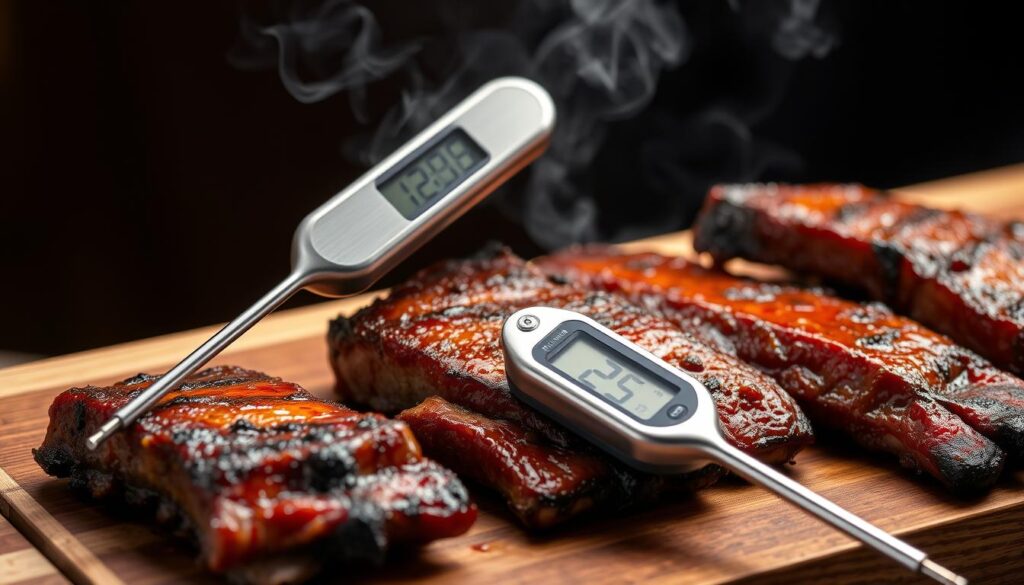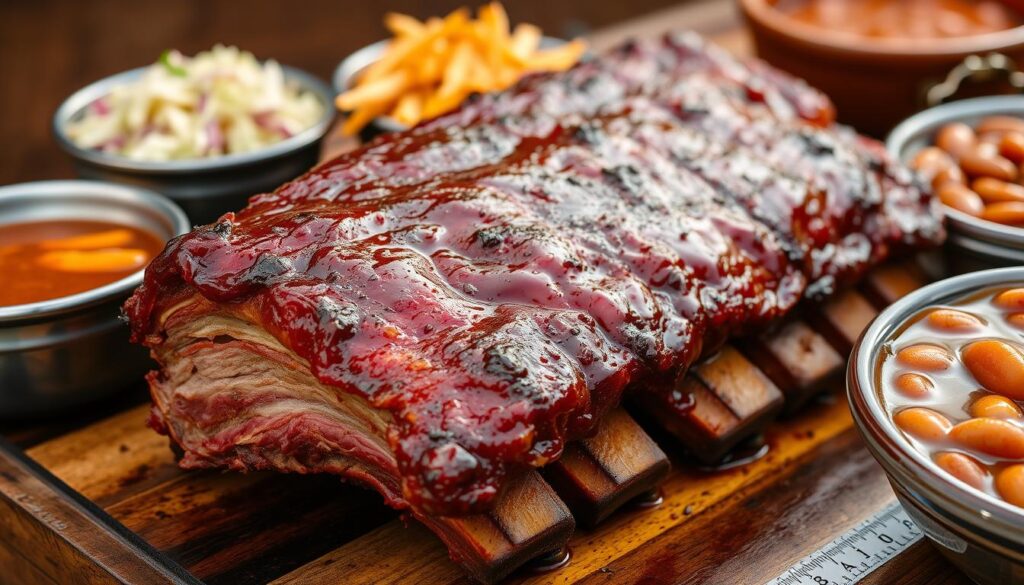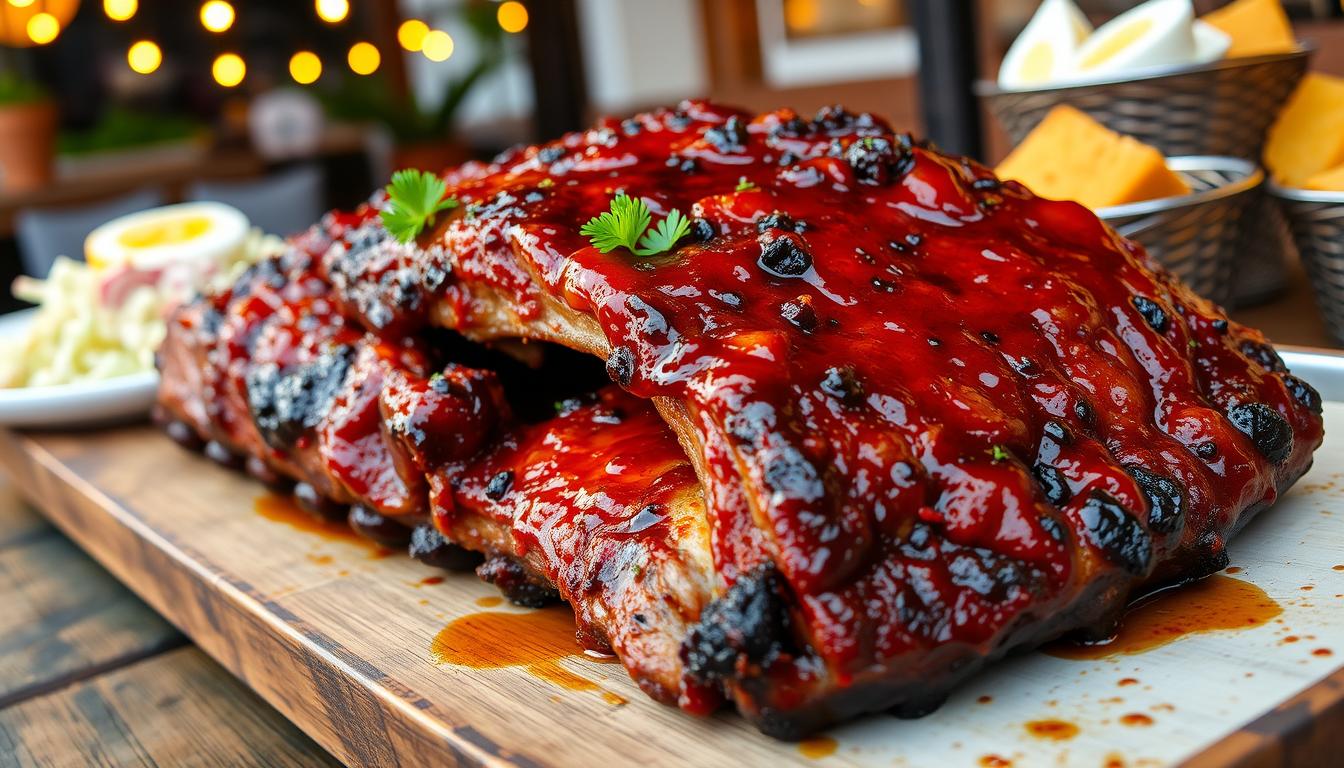When the smell of slow-smoked beef ribs fills the air, my mouth starts to water. Growing up in barbecue country, I love making perfect ribs. Whether you’re an expert or just starting, learning to make great barbecue beef ribs is exciting.
Beef ribs are a favorite in Southern and Chicago-style cooking. They’re known for their rich taste and tender texture. To get this taste, you need to prepare them well, cook them slowly, and use the right seasonings and smoke. This guide will help you learn how to make amazing ribs at home.
Key Takeaways
- Understand the different types of beef ribs and their unique characteristics
- Discover the essential equipment needed for smoking and grilling beef ribs
- Learn the proper techniques for trimming, seasoning, and cooking beef ribs low and slow
- Explore the art of creating the perfect dry rub blend to enhance the natural flavors
- Uncover the secrets to achieving the perfect smoke ring and tender texture
Understanding Different Types of Beef Ribs
Beef ribs come in various cuts, each with its own taste and cooking method. It’s key to know the differences to make delicious barbecue beef ribs at home.
Back Ribs vs. Short Ribs
Back ribs are lean and tender, coming from the rib section near the spine. They need less prep time. Short ribs, from the lower rib cage, are meatier and more flavorful.
Plate Short Ribs vs. Chuck Short Ribs
Plate short ribs come from the lower rib cage and are rich in flavor. They have a lot of meat and fat, perfect for smoking. Chuck short ribs, from the chuck area, are meaty and great for grilling, BBQ, and smoking.
Quality Grades and Marbling
The quality grade of beef, like Prime, Choice, or Select, shows the marbling level. More marbling means more tender and flavorful ribs. Proper cooking is key to bringing out the best in different cuts.
| Rib Cut | Fat Content | Flavor Profile | Ideal Cooking Method |
|---|---|---|---|
| Back Ribs | Leaner | Juicy and tender | Grilling, Smoking |
| Short Ribs | Meatier, More Flavorful | Rich, Blend of Brisket and Steak | Smoking, Braising |
| Plate Short Ribs | High Meat Content and Fat | Robust Flavor | Smoking |
| Chuck Short Ribs | Favorable Meat-to-Fat Ratio | Meaty | Grilling, BBQ, Smoking |
Knowing the unique traits of different beef rib cuts is essential for making amazing barbecue beef ribs. By choosing the right cut and cooking method, you can bring out the best in these tasty and tender ribs.
Essential Equipment for Smoking Barbecue Beef Ribs
Smoking delicious barbecue beef ribs requires the right tools. A top-notch smoker, whether it’s charcoal, gas, or electric, is crucial. Also, don’t forget the wood chips or chunks for that smoky taste. Choose hardwoods like oak, hickory, or fruit woods like apple or cherry for the best flavor.
A reliable meat thermometer is a must. It helps you get the ribs to the perfect internal temperature. You’ll also need heavy-duty aluminum foil for wrapping, a spray bottle for misting, and heat-resistant gloves for handling hot meat.
| Equipment | Purpose |
|---|---|
| Smoker (charcoal, gas, or electric) | Provides the heat and smoke for slow cooking the ribs |
| Wood chips or chunks (oak, hickory, fruit woods) | Adds the essential smoky flavor to the meat |
| Meat thermometer | Ensures the ribs reach the perfect internal temperature |
| Aluminum foil | For wrapping the ribs during the cooking process |
| Spray bottle | Used to spritz the ribs with liquid during smoking |
| Heat-resistant gloves | Protects your hands when handling the hot meat |
With these tools, you’re ready to make amazing smoky barbecue beef ribs at home. Quality equipment and attention to detail are key to success.
Preparing Your Ribs for the Smoker
Getting your barbecue beef ribs ready is key to a great taste. First, trim off any extra fat and remove the tough membrane from the back. This makes sure the ribs cook evenly and soak up the smoke and seasonings well.
Dry Brine Technique
Then, use a dry brine to boost the ribs’ flavor and tenderness. Sprinkle salt all over the meat, cover it, and chill in the fridge for 2 to 4 hours, or overnight. This helps the salt draw out moisture and intensify the beefy taste.
Applying the Rub
After dry brining, it’s time for a thick, tasty dry rub. Mix together salt, pepper, garlic powder, onion powder, and brown sugar. Rub this mix into every part of the ribs, making sure they’re evenly coated. You can rub them right before cooking or a few hours ahead for even more flavor.
“The key to succulent, falling-off-the-bone barbecue beef ribs is in the preparation. Dry brining and a well-crafted dry rub are essential steps that will have your guests raving about your smoked masterpiece.”
Now that your ribs are prepped and seasoned, it’s time to fire up the smoker. Get ready for a tasty low and slow cooking adventure. Next, we’ll explore the art of choosing the right wood and managing the smoke.
Creating the Perfect Dry Rub Blend
A great dry rub can make barbecue beef ribs truly special. The right mix of spices and seasonings can bring out the meat’s natural flavor. This turns your ribs into a culinary work of art.
A classic dry rub includes brown sugar, salt, black pepper, and paprika. You also add garlic powder and onion powder. For more flavor, some people add cumin or chili powder. Coffee grounds or unsweetened cocoa powder can add an extra layer of taste.
| Ingredient | Amount |
|---|---|
| Brown Sugar | 1/4 cup |
| Smoked Paprika | 1 Tbsp. |
| Salt | 1 1/2 tsp. |
| Garlic Powder | 1 tsp. |
| Mustard Powder | 1 tsp. |
| Onion Powder | 1/2 tsp. |
| Black Pepper | 1/2 tsp. |
Creating the perfect dry rub is all about experimenting. Try different mixes until you find the flavor you love. Whether you like it sweet, savory, spicy, or smoky, there’s a blend for everyone. Once you’ve got your rub, rub it on the meat before cooking or let it sit for hours to deepen the flavors.
Homemade dry rubs let the beef’s natural taste shine. By balancing spices and seasonings, you can make your barbecue beef ribs unforgettable. Your guests will be talking about them for a long time.
Wood Selection and Smoke Flavor Profiles
Choosing the right wood is crucial for smoking delicious barbecue beef ribs. The wood you pick can add a wonderful smoky taste and help create the smoke ring. Popular hardwoods like oak, hickory, and mesquite each bring their own flavor.
Best Woods for Beef Ribs
- Post Oak: It burns for a medium time and has moderate heat. Post oak is a favorite for 90% of barbecue fans. It adds a classic smoky taste to beef ribs.
- Hickory: It burns for a medium to long time and has hot intensity. Hickory wood gives a strong, bacon-like flavor to your ribs.
- Mesquite: It burns fast and hot, making it the most intense wood. Mesquite wood gives a bold, strong smoke flavor.
- Pecan: It has a mild to medium smoky taste with a hint of nuttiness and sweetness. Pecan wood is a good choice for beef ribs.
- Cherry: It burns for a short to medium time and has low heat. Cherry wood adds a light, sweet smoke that’s great for shorter cooking times.
For consistent, high-quality smoking, try Western Wood Chips and Chunks. They are kiln-dried and burn well. Jack Daniel’s BBQ products are also popular. They use wood chips and chunks from retired oak whiskey barrels, giving a unique aroma.
Smoke Ring Development
The pink smoke ring on smoked beef ribs comes from a chemical reaction. This reaction happens between the meat’s myoglobin and the nitric oxide in the wood smoke. Keeping the smoke thin and clean is key to getting this beautiful ring.
Managing Clean Smoke
To get clean, consistent smoke, watch the airflow in your smoker. Avoid thick, white smoke, as it can make the ribs taste bitter. Managing wood chips or chunks and controlling the temperature are important. They help create the perfect blue-tinged smoke for your ribs.
Temperature Control and Cooking Times
To get perfectly cooked barbecue beef ribs, you need to control the temperature well. Keep your smoker or grill at 225-250°F (107-121°C) for 6-8 hours. Make sure the meat’s internal temperature hits 195-205°F (91-96°C). Always use a meat thermometer to check both the smoker and the ribs.
Some pitmasters wrap the barbecue beef ribs in foil or butcher paper halfway through. This method, called the “Texas crutch,” keeps the ribs moist and tender. But, it’s key to balance wrapping and unwrapping to get a tasty bark on the outside.
Keeping the slow cooking temperature steady is vital for great ribs. By watching the temperature and making adjustments, you’ll get ribs that are tender inside and caramelized outside.
“The key to perfectly cooked barbecue beef ribs is all about temperature control and patience. Slow and steady wins the race when it comes to achieving that fall-off-the-bone tenderness.”

The Science Behind Low and Slow Cooking
Barbecue beef ribs become tender by cooking them low and slow. This method uses temperatures between 225°F and 275°F for hours or even a day. It breaks down tough collagen into gelatin, making the ribs juicy and tender.
Collagen Breakdown Process
The collagen starts to break down at 160°F (71°C). As the temperature goes up, the collagen unwinds and turns into gelatin. This change is key for tender meat, as gelatin keeps it moist and tender.
Moisture Retention Methods
Keeping the meat moist is crucial when cooking barbecue beef ribs low and slow. Spritzing the meat with liquid, using a water pan in the smoker, and wrapping the ribs in foil or paper help. These methods prevent the meat from drying out during long cooking times.
| Cooking Method | Temperature Range | Cooking Time |
|---|---|---|
| Low and Slow | 225°F – 275°F | Several hours to a full day |
| Hot and Fast | 350°F – 450°F | 2-4 minutes per side |
The low and slow method breaks down collagen slowly, making the meat tender and juicy. The hot and fast method creates a flavorful sear on the meat’s surface through the Maillard reaction.
“Cooking low and slow, collagen and connective tissue break down at temperatures ranging from 180°F to 205°F creating tender results.”
Mastering the Texas-Style Barbecue Beef Ribs
If you love barbecue, learning Texas-style beef ribs is a must. This style is simple, letting the meat’s natural flavor stand out. A few key techniques are needed to perfect Texas-style beef ribs.
First, keep the membrane on the ribs’ back. This helps the meat stay together when you slice it. Also, trimming the silver skin and connective tissue is key for better smoke and seasoning.
For seasoning, use a simple mix of salt, black pepper, and maybe some garlic powder or paprika. The aim is to highlight the smoky, beefy taste without too many spices.

Smoke the ribs over post oak or mesquite at low heat, 225°F to 250°F. This slow cooking, 12 to 16 hours, makes the meat tender and juicy.
Serving the ribs is all about the beef. Serve the sauce on the side, so guests can add as much as they like. This way, the smoky, beefy taste is the main focus.
Learning Texas-style barbecue beef ribs takes time, but it’s worth it. With the right techniques and patience, you’ll make ribs that everyone will love. So, fire up your smoker, get some slab beef ribs, and start your flavorful journey.
Glazing and Finishing Techniques
Take your barbecue beef ribs to the next level with amazing glazing and finishing tricks. Use spritz solutions like apple cider vinegar, apple juice, or beef broth to add flavor and moisture. Try wrapping methods like the Texas Crutch (foil) or butcher paper to cook faster and keep juices in.
Spritz Solutions
While your ribs smoke, grab a spritz bottle with a tasty liquid. Mist the meat every 30-45 minutes to keep it moist and tender. Mix apple juice, apple cider vinegar, and water for a classic taste, or use beef broth for a rich umami flavor.
Wrapping Methods
The 3-2-1 rib cooking method is a game-changer. Smoke the ribs at 225-250°F for 3 hours. Then, wrap them in foil or butcher paper for 2 hours. This “Texas Crutch” steams the meat, making it tender.
In the last hour, unwrap the ribs and brush on a tasty glaze or sauce. The sugars will caramelize, giving a sticky, shiny finish. Make sure to glaze in the last 30 minutes to avoid burning.
For the best finish, let your ribs rest for 10-15 minutes before slicing. This lets the juices spread evenly, making every bite moist and flavorful.
With these expert glazing and finishing tricks, your barbecue beef ribs will impress everyone. Try different spritz solutions and wrapping methods to create your own style. Get ready to amaze your guests with the most tender, juicy, and flavorful ribs they’ve ever had.
Conclusion
Learning to make great barbecue beef ribs is all about knowing your meat, prep, seasonings, and cooking ways. You can use a smoker or an oven, but keep the heat low and cook for a long time. This ensures your ribs are both tender and full of flavor.
Try out different woods, rubs, and sauces to make your ribs unique. Use methods like the 3-2-1 or 2-1-1 for baby back ribs to get amazing results. Your own taste is key, so don’t be afraid to experiment.
Keep working on your barbecue beef ribs skills and don’t hesitate to try new things. Whether you like strong or sweet flavors, find the cooking method that suits you. With quality ingredients and a love for grilling, you’ll make ribs that everyone will love.
FAQ
What are the key features of barbecue beef ribs?
What are the different types of beef ribs?
What equipment is needed for smoking beef ribs?
How do you prepare beef ribs for smoking?
What makes a good dry rub for beef ribs?
How does wood selection affect the flavor of smoked beef ribs?
What are the keys to maintaining consistent temperature when smoking beef ribs?
How does the low and slow cooking process affect beef ribs?
What are the key characteristics of Texas-style beef ribs?
What finishing techniques can elevate the flavor of barbecue beef ribs?
Source Links
- Make These Unforgettable Slow-Grilled Beef Ribs, You’ll Thank Us Later! – https://www.thespruceeats.com/slow-grilled-beef-ribs-335856
- Classic Barbecue Beef Ribs Recipe : Best Homemade BBQ Sauce 2024 – https://www.meatmasterecipes.com/barbecue-beef-ribs-recipe-homemade-sauce/
- Types of Beef Ribs Explained (How To Tell Them Apart) – https://carnivorestyle.com/types-of-beef-ribs/
- Everything You Need to Know – https://www.tysonfoodservice.com/solutions/news-and-insights/beef-ribs-vs-pork-ribs-everything-you-need-to-know
- The Ultimate Guide to Ribs – https://www.smokehouse.com/blog/post/the-ultimate-guide-to-ribs?srsltid=AfmBOorZTP0A7qI3r7__xCotCEcNPsJDt_pCLJazgo5QUWIdOvtWh5_Q
- Smoked Beef Ribs – https://meghanitup.com/smoked-beef-ribs/
- How to Smoke Dino Ribs aka “Beef Ribs” – https://backyahdbbq.com/dino-ribs/
- Perfect Beef Ribs for Wood Smoked BBQ: Top Tips – https://centralcitybbq.com/perfect-beef-ribs-for-wood-smoked-bbq-top-tips/
- Smoked Beef Back Ribs – Learn to Smoke Meat with Jeff Phillips – https://www.smoking-meat.com/april-10-2014-smoked-beef-back-ribs
- Bold Rib Rub Recipe with Brown Sugar – https://sundaysuppermovement.com/rib-rub-recipe/

